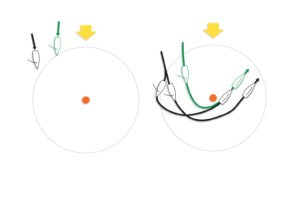TECHNIQUE
How do you optimize your rig for speed? Where should you position your feet when stepping out on the wire? How do you divide responsibilities in a campaign? To master the mechanics of sailing, look to this group.
Crewing to Win by Andy Hemmings,
Helming to Win by Lawrie Smith & Ian Pinnel
From Fernhurst Books Sail To Win Series (14 nuts-and-bolts texts about racing) come two books on dinghy skills: Andy Hemmings Crewing to Win and Lawrie Smith and Ian Pinnells Helming to Win.
These champions tell and, more importantly, show how to sail planing dinghies well. While veterans will likely find some of the text elementary (and some of the information may not apply to all designs), every dinghy sailor will find something useful here. For junior, novice and intermediate sailors, these books are excellent sources. They describe fundamentals of preparation, boathandling and sail trim, leaving the nuances of physical training, tactics, strategy and the rules to other texts in the series.
Written like owners manuals, these books offer detailed descriptions of most maneuvers. For example, heres Hemmings on basic trapeze technique: “Cleat the jib, but keep the sheet near at hand. Raise the height of the trapeze ring to just clear of the deck, so that you are easily able to hook on.”
Smith and Pinnell on heavy air, upwind boat trim: “Sail the boat absolutely upright with the crew trapezing low enough to be just skimming the water. You should be hiked out as far as possible, but in a comfortable enough position to play the mainsheet and steer efficiently. Keep your weights together, with the crews front foot 18 to 24 inches behind the shroud.”
Black and white photographs demonstrate many of the skills, step-by-step. Both titles include techniques particular to skiffs as well as traditional planing dinghies. Bear in mind that the authors and the publisher are British so some terms may be unfamiliar (a “kicking strap” is a boom vang and “twinning lines” are twings). (1994 Fernhurst Books; 95 pp each; $20.95 each)
Keelboat & Sportsboat Racing by Glyn Charles
In a new edition expanded to include sportboats, Charles covers the basics of rig tuning, boat-handling and spinnaker work with special attention given to areas of particular importance to this growing population of lightweight speedsters, such as acceleration, wave riding and asymmetric chutes. (1997 Fernhurst, 96pp, $22)
High Performance Racing by John Merricks and Ian Walker
Olympic silver medalists John Merricks and Ian Walker (470 in 1996) take you into the next generation of sailing — skiffs and high-performance dinghies. This book looks at technique, boathandling, preparation and new course strategies. (1996 Fernhurst, 128pp, $26.95)
Championship Laser Racing by Glenn Bourke
Three-time Laser world champion Glenn Bourke takes you through the ins and outs of this popular one-design. Black and white photographs and step-by-step explanations make this a very user friendly book. (1993 Fernhurst, 96pp, $20.95)
North U. Fast Course and North U. One-Design Course
These two textbooks from North Sails seminar series offer insight into boatspeed, sail trim and handling. Fast also has a compilation of previously published articles aimed at the big boat racer, while One-Design is focused on keelboats and dinghies. (1992 North Sails, 258pp, $19.95 each)
Performance Racing Trim by Bill Gladstone
One of the two-part Gladstone Performance Racing series, this book discusses sail trim, boathandling, preparation and tuning. Explanations are short, clear and simple, with useful illustrations. Geared to the keelboat and big-boat racer. (1996 Bill Gladstone Sailing Services, 180pp, $25)
Catamaran Racing for the 90s by Rick White and Mary Wells
Rick White and Mary Wells offer 337 pages of tips, tricks and checklists specifically for catamaran sailors. The manual covers everything from righting the boat after a capsize to sail set-up and tactical rules of thumb. A must-read for beginning and intermediate racers; class veterans will especially enjoy 10 interviews with multihull stars Randy Smyth, Carlton Tucker, Hobie Alter Jr. and others. (1997 Ram Press, 337pp, $31.95)
The Winners Guide to Optimist Sailing by Gary Jobson and Jay Kehoe
Opti-dad Gary Jobson combined forces with U.S. Opti Team coach Jay Kehoe to create a comprehensive guide for kids learning to sail and race in Optis. With illustrations by Brad Dellenbaugh and plenty of photographs, the information is presented in short, easy-to-read bits that most 11-year-old sailors will enjoy. (1997 Simon & Schuster, 173pp, $15)
SCIENCE
While many authors discuss the principles of performance, few books are dedicated to explaining the science of sailing. If you ever considered what effect a particular sail shape, rigging technique or wind strategy would have on your sailing, these books are for you.
High Performance Sailing by Frank Bethwaite
In 1960, “something unexpected was happening” to Frank Bethwaite, a professional pilot and avid sailor. Basing tactical decisions on rules of thumb about local wind conditions, he and his wife lost a race they should have won. Bethwaites search for an explanation led to a comprehensive study of the science of sailing.
Touted by Sailing Worlds Senior Editor at Large Ed Adams as “The most significant scientific thinking about sailboat racing to come along in three decades,” High Performance Sailing describes the fundamental elements of performance sailing, and elucidates the physics and meteorology at work.
Dont let the title and cover photo of the Aussie 18-foot skiff fool you. This book is about racing all types of boats. Get it, read it, review it, use it. No rule of thumb goes unchallenged. No assumption stands.
For example: “Because sails look like wings, it used to be believed that sails and wings worked in the same way. They dont.” Or: “The customary explanation of the sea breeze — that the air over the land is warmed and rises, so the cooler air from the sea flows in to fill the void — is so simplistic as to be misleading. The truth is much more interesting.”
The book opens with a discussion of wind systems as they relate to racing sailors. Bethwaite then tackles the water, the boat and boathandling. You wont page through it in one sitting, but despite the dense material, the jargon and terminology are not overwhelming. However, High Performance Sailing may be better suited for experienced racers who will read it, look back on experiences and say “Oh, thats what happened.” (1993 International Marine, 414pp, $32.95)
Sailpower: The Science of Speed by Smith & Preece
From hull shape to sail design, this book gives it to you straight and simple. Series of black and white photos demonstrate many maneuvers. Useful advice for both the keelboat and the dinghy sailor. (1994 Fernhurst, 128pp, $22.95)
The Art & Science of Sails by Tom Whidden & Michael Levitt
Straight from the president of North Sails comes this guide to modern materials, construction, aerodynamics, upkeep and use. An excellent reference for everyone — racers, cruisers and boardsailors alike. (1990 St. Martin Press, 357pp, $37.50)
The Aero-hydrodynamics of Sailing by C.A. Marchaj
For those who love the challenge of calculus and appreciate a deeper technical understanding of the forces at work on a sailboats hull, sails and appendages, Marchajs 700-page Aero-hydrodynamics of Sailing is a heavily illustrated and authoritative reference essential. (1988 Dodd, Mead & Company, 741pp, $124.50)
Principles of Yacht Design Larsson & Eliasson
This text examines every aspect of the design process from CAD techniques, to hydrostatics and stability, to aerodynamics and rig and hull loads, to deck and cabin layouts. Written clearly enough for the amateur; professionals will also find it of interest. (1994 International Marine, 302pp, $39.95)
Wind Strategy by David Houghton
Houghtons Wind Strategy serves as the Sail to Win Series basic text on surface wind, with explanations of gradient, sea and land breezes; effects of temperature, geography and current; and how to read clouds. Includes tear-out waterproof summary sheets for on-the-water reference. (1992 Fernhurst, 96pp, 20.95)
SMARTS
For many, the cerebral side of sailing makes some of the best reading. Fortunately, there are more than a few offerings to whet your appetite. A warning: The new rules have changed tactics somewhat. That said, most of the advice in these books will still be very useful.
North U. Smart Course by North Sails
“Strategy is the general plan you have for how to get around the buoys as quickly as possible. Tactics are the tools you use to implement your strategy amidst a fleet of boats. And rules are necessary to prevent collisions and ensure fairness.”
David Dellenbaugh drives home the essentials of this often-overlooked distinction by breaking down each of these elements in the North Sails North U. Smart Course book, which he significantly edited and revised after its original publication by Robert Hopkins in 1980. The manual was intended as a North U. seminar text, but it, like all the other North U. titles, can be purchased independently.
Presented in workbook format, each chapter contains basic lessons illustrated with excellent diagrams and illustrations by Brad Dellenbaugh, followed by a set of “Problems” (the answers are in the back of the book). For further reading, articles on related topics reprinted from this magazine are also included in each chapter, and in the back there is a handy glossary that defines such terms as “Coriolis force,” “ladder rungs,” “slam dunk” and “velocity shift.”
In a small amount of space, the manual covers a tremendous amount of information in a clearly written, easily understood style. However, youll want to skip over pages 32 through 59. This is the rules section, and like most tactics books currently available, it has not been updated for the new rules. Three articles at the end of this section on how to prepare and present a protest are valuable resources, but the rest of the discussion contains outdated references. Instead, supplement it with one of the rules texts listed above. (1992 North Sails, 252pp, $19.95)
Winning in One-Designs by Dave Perry
More likely than not youll find this classic already sitting on your sailors shelf, and for good reason. In chapters that originally appeared as columns in this magazine, Perry explains the fundamentals of successful one-design sailing — from rules to boatspeed to tactics — in his typically fun-to-read style. (1992 US SAILING, 293pp, $16.95)
Navigation, Strategy and Tactics by Stuart Quarrie
This book offers one of the best descriptions of the navigators role. Explanations of key concepts like true, apparent and sailing wind, or targets and polars, will give you a powerful strategic arsenal and take the mystery out of strategic navigation. Although most information is valid for all sailors, this is a must-read for keelboat and offshore sailors. (1993 Guardian Newspapers Ltd, 190pp, $23.50)
Performance Racing Tactics by Bill Gladstone
Originally used as a seminar text, this book offers insight into planning the fastest way around a racecourse, and what to do when other boats get in the way. The only tactics and strategy discourse we found (at press time) that has current references to the new rules. (1997 Gladstone Sailing Services; 200pp; $25)
Tactics by Rodney Pattison
Another offering from Fernhursts Sail To Win series, Pattisons Tactics is a no-nonsense look at successful strategy and tactics. The Olympic medalist dissects the racecourse to discuss various tactical considerations from port-end biased lines to crowded mark roundings. (1992 Fernhurst, 94pp, $20.95)
Advanced Racing Tactics by Stuart Walker
“So is this a category I breeze or a category III?” If youve forgotten which is which, this is the text in which Sailing Worlds columnist defines three categories of wind and explains the tactics and strategies to use in each. “My favorite Walker book of all-time,” says Sailing World Editor John Burnham. (1976 Norton, 399pp, $19.95)
Championship Tactics by Gary Jobson, Tom Whidden, and Adam Loory
With anecdotes from famous yacht races, Americas Cup tacticians Gary Jobson and Tom Whidden cover a full range of tactical opportunities from starts to mark roundings, upwind and downwind legs, and fast finishes. (1990 St. Martin Press, 355pp, $35)
Reviews compiled by Geoff Oxnam, an independent marine journalist based in Annapolis, Md.
Where to shop
If youre shopping for great sailing reads, dont forget to look for more than just instructional titles. The sailors bookshelf should contain stories of great races, histories of the sport, as well as a few good novels. There are a host of great coffee-table books available as well.
If your area does not have a good marine bookseller (dont overlook the chain stores), try the following:Armchair Sailor 800/29CHART (orders) 401/847-4252 (info) 401/847-1219 (fax) www.seabooks.com
Blue WaterBooks & Charts 800/942-BLUE www.bluewaterweb.com
Delta Trade Paperbacks 212/782-8664 212/782-9341 (fax)
East Shore Sailing (Fernhurst Books distributor) 607/387-6347607/387-6353 (fax) www.sailingsource.com/fernhurst
Bill Gladstone Sailing Services 847/869-6534 847/869-6780 (fax) BGSailing@AOL.com
International Marine
800/2-MCGRAW www.books.mcgraw-hill.com
The Nautical Mind 416/203-1163 416/203-0729 (fax)
North Sails (catalog) 800/626-9996
Spectrum Nautical Inc. 800/500-6745 Snautical@Juno.com
Sheridan House 914/693-2410 914/693-0776 (fax)
Trafalgar Square 802/457-1911
US SAILING 800/US SAIL-1









